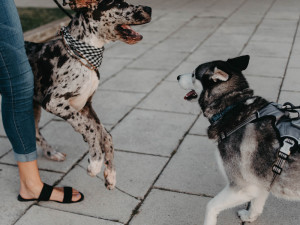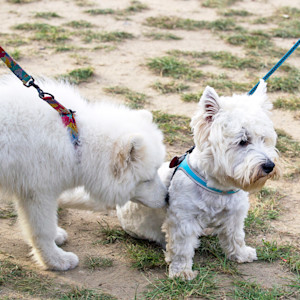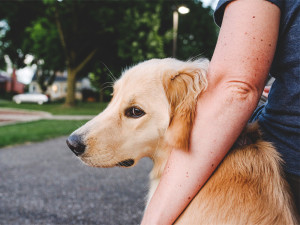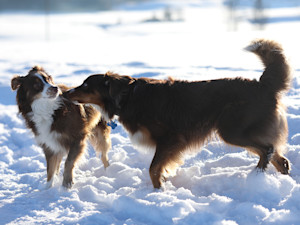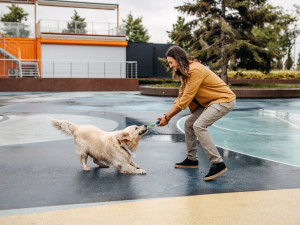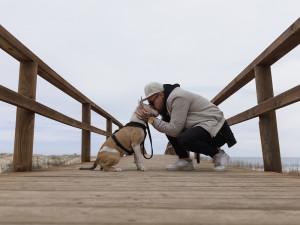How to Reprimand Your Dog: A Guide to Positive Reinforcement
Never, ever punish your dog. Here’s why positive reinforcement is the only way to go.
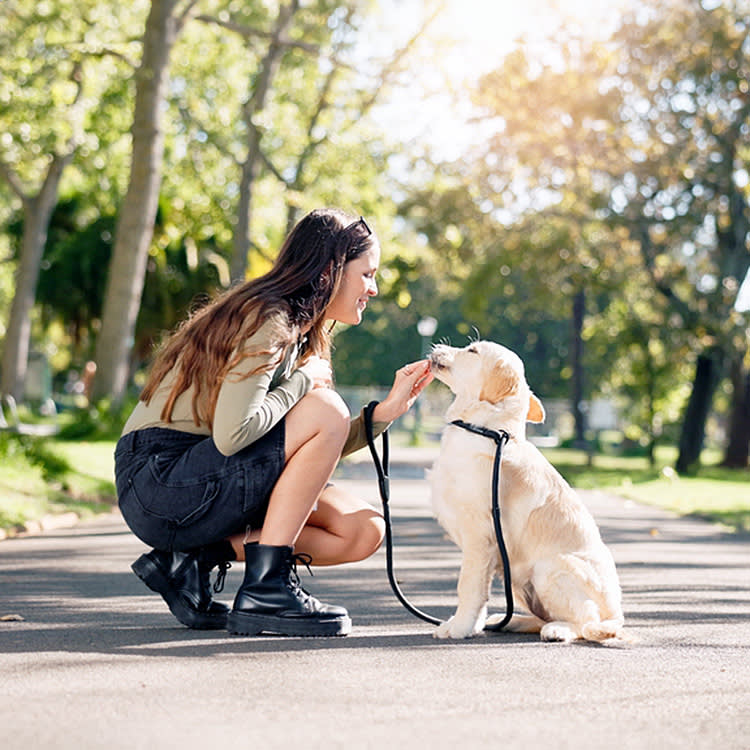
Share Article
In This Article:
Why Positive Reinforcement?opens in a new tab Effective Positive Reinforcement Techniquesopens in a new tab How to Manage Triggersopens in a new tab Structured Rewardsopens in a new tab How to Stop Jumpingopens in a new tab How to Stop Barkingopens in a new tab How to Stop Nipping and Bitingopens in a new tab How to Find a Traineropens in a new tab
Let’s just get this out of the way immediately and in no uncertain terms: Punishment is an outdated way of dog training. Dogs do not understand punishment, and when you use punishment as your method of training, your dog may become insecure for a period of time and then stop listening.
Over the years, dog training has come a very long way. The majority of veterinarians and trainers are recommending the use of positive reinforcementopens in a new tab to train your dog, and Kinship promotes only this method of training. Positive reinforcement is based on the science of how animals learn. Positive reinforcement builds your dog’s confidence and creates a dog who is willing and eager to do what is asked of them.

littleKin™ is Kinship’s home just for puppy and kitten parents. Bop over to check out expert advice, new pet tools, and special deals—all curated for your newest family member.
opens in a new tabWhy positive reinforcement?
Ugh, what is that smell?!
“Did you poop in the house again? Where is it? Why can’t you just poop outside like other dogs? We don’t poop inside!” If this is how you speak to your dog, expect them to sit there clueless as to what you are saying. They will probably just respond with a low tail wag, unsure what’s going on.
Having accidents in the house can happen when you have a dog, but yelling at your dog for an accident will not stop this issue. Yelling will not stop the pooping. It will teach your dog to continue to poop in the house — but just make sure they don’t do it in front of you. This will make potty training even harder for you and for them. Your dog may even become afraid to poop in front of you on a leash due because they are afraid you will yell at them.
Instead, do not react at all. If an accident happened, and you did not catch your pup in the act, calmly clean up the mess. If you see your dog poop, you can try your best to calmly interrupt them and take them right outside to finish their business. Be sure to reward them with a treat or praise if they use the bathroom outside.
Effective positive reinforcement techniques
Again, vets, behaviorists, trainers, and dog parents have begun to stray away from punishment as a way to train dogs. This is because of the fallout that comes with punishment methods of training. The research has confirmed opens in a new tabthat punishment is known to cause behavioral and health issues for your dog.
Instead, dog parents and those in charge of their health and wellness have changed to using positive reinforcement as a means of training. Many parents and trainers who use positive reinforcement feel that their dogs are more willing to follow along than those who use negative ways of training. This may be because positive reinforcement teaches your dog what to do, instead of what not to do. Your dog will learn the correct behavior that you are looking for rather than just being punished for what they do wrong without learning what you are looking for.
Treat-based rewards
In the beginning stages of positive reinforcement, treats can be a large piece of the puzzle. When using treats in training you want to base the value of the treats on what you are asking your dog to do. When you are asking your dog to learn a new skill, something that is tricky for them, or practice a learned behavior in an overstimulating environment, you will want to use a high-value treat ( i.e., liver, low-sodium turkey dogs, freeze-dried raw kibble pieces). Treats allow you to reward your dog quickly and precisely to help them understand the treat came because you completed this behavior.
As your dog learns what to do, you can begin to fade the treats, and your dog will be happy to do the behavior for love and affection.
Praise and affection
While you begin your training using treats as a reward, you want to pair the reward with praise and affection. This will help you phase out the treats over time. Be enthusiastic with your affection and verbal praise as you give them the treats. Think treat, pet, voice, treat, pet, voice as you are rewarding your dog. This will help you pepper in all three components of a something positive for your dog when they do something great.
Play and toys
Toys or play are a great way to praise your dog without using treats. Ask your dog to do something like sit, when they do it, throw the ball, or toss them a toy. Ask your dog to stay, and when you release them, run their tug toy along the ground like prey and get them to engage in tugopens in a new tab. The more fun you make training for your dog, the more your dog will want to engage with you.
Clicker training
Clicker trainingopens in a new tab allows you to be very precise with your training. The click happens at the exact time your dog completes the desired behavior, but the reward comes after. You first start by pairing the clicker sound with treats. Click reward, click reward, reward right away. Repeat this step over and over. Once your dog recognizes the sound, wait for them to look away and then click. Reward them when they turn to you. Over time, you can make the click sound when your dog is doing a behavior, and they will know to come back to you for the treat.
How to manage triggers
In order to help manage a behavior, you need to understand why it is happening. Most behaviors humans dub “bad” are just your dog fulfilling a natural instinct, such as barking, digging, humping, destruction etc. Is your dog stressed, sick, not getting enough exercise, getting too much exerciseopens in a new tab, or scared? Once you have figured out the reason your dog is acting out, then you can work on managing the behavior with the hope of stopping it altogether.
An example would be if your dog is digging in the bed opens in a new taband frequently ripping a hole in it. Giving them an appropriate outlet to dig like a sandbox may help stop this behavior in the bed.
Structured rewards
Every dog is different, the reward that works for one dog may not work for another.
Some dogs like food rewards as simple as kibble, some need something more flavorful like liver to be motivated during training. Some dogs love when you rough-house with them, but sensitive dogs would rather you give them a gentle pet on the ears. When rewarding your dog, it is important to reward them in a way that they enjoy.
When you reward them, observe how they react. If you pet them and then quickly stop, do they come in for more? Does their body look loose, or do they back away and look tense? Keep in mind the signs of stress dogs show, and look out for them when engaging and petting your dog. This will help you understand what your dog likes and doesn’t like.
How to stop jumping
Jumping is a hard behavior to work through because some people love a dog who jumps and some hate it, so it is important to get everyone on board when you start your training. A dog who jumps on peopleopens in a new tab can be a huge hazard. If a dog jumps on the wrong person, they can injure them. If you want to allow your dog to jump, it is best to use a jumping cue. Make it something you invite your dog to do; that way, you can keep others safe from their shenanigans.
Ignoring jumping behavior
Ignoring jumping from the start is a huge part of getting your dog to stop jumping. A puppy might be cute and fun when they jump on you. But a 10-pound dog who jumps is not the same when they are 50 pounds. If your dog jumps on you, do not yell at them to get off or push them away. This makes jumping a game. Ignore them. Just stand there or turn away, and wait until their four feet are on the ground. Only pet them then. Repeat this over and over.
When a stranger asks to pet your dog, you can tell them, “No.” Because any time your dog has a chance to jump, your training goes out the window. If you decide to let them pet your dog, begin by telling them that your dog is in training and to ignore them if they jump. Then shorten the leash so your dog will not be able to get any height if they do try to jump.
Using strangers to help train your dog can be hugely beneficial. You just need to be willing to speak up for yourself and your dog, because each time your dog engages in a behavior that you do not want — like jumping — you are increasing the likelihood that your dog will engage in that behavior in the future.
Rewarding calm greetings
When your dog is getting pet, calmly reward them for keeping their four feet on the ground. Give them the reward when they are engaging with the person petting them and staying on the ground. Be sure not to reward them if they are paying attention to you or acting hyper. You want them to understand that the treat comes when they are calmly engaged with the person who is petting them.
Identify alternative behavior
Playing the “sit” game is a great way to train your dog not to jump when you are petting them. Ask your dog to sit, and then give them all the pets and love they could want. As soon as they step out of the sit position, stop petting them and ignore them.
When they sit back down, engage in the petting and love again. Play this over and over. Dogs are smart and they will catch on that they get love when they are sitting. This is a great game to play with all of your family members within the home and any visitor you have. Over time, your dog will get it and learn to request love and pets by sitting next to you instead of jumping.
How to stop barking
Barking can be a helpful (and annoying) behavior. Barking can get your attention if there is an intruder outside; it can deter unwanted people or animals from coming close. Barking can also wake a baby, be incessant, or cause issues with your neighbors. You can stop your dog from barking incessantly with patience and a lot of training.
Identifying and addressing triggers
As always when your dog is doing a behavior that you want to stop or decrease, you need to figure out why they are doing it. Is a squirrel taunting your dog from the window? Do they want the ball that rolled under the couch? Do they hear a sound you don't hear?
Once you have addressed why they are barking, you can move on to working on getting it to stop. Shades can help block your doors or windows to prevent your dog from seeing the squirrels or neighbors walking by. Sound machines or the TV can help block out unwanted sounds that may make your dog bark.
The “quiet” command
Get your dog to bark. Once your dog is barking, do something to distract them from it and get their attention by picking up a toy or making a sound. When they look away from what they are barking at, stop and reward them with a treat.
Repeat this over and over, gradually making the period between the barking and the treat longer. Once your dog is consistently quieting, you can begin to add the word “quiet” to the chain of events. Your dog may have spent a lot of time being reinforced by barking, so it may take a while for them to understand the quiet cue.
Desensitization
Desensitizing your dog to the trigger starts with small and slow exposures. This is a long process and takes many calculated exposures. If your dog barks at thunder, you can begin to play low, quiet thunder sounds while they eat dinner. Gradually make it louder as they continue to stay comfortable. If you notice them being bothered by the sound, go back to the lower volume. Do this repeatedly until you can play the thunder sounds loud enough, simulating real thunder.
Counterconditioning
Counterconditioning is a way to help your dog learn to feel positive about something they do not enjoy. Any time your dog sees their trigger, you will reward them, no matter how your dog reacts. This repeated reward will teach your dog that when they see the scary thing, a treat comes. Over time, it will help your dog stop acting negatively toward the trigger, because they will now be conditioned to feel a different way.
How to stop nipping and biting
Nipping and biting is a natural behavior for your puppy. One reason it is important to keep your puppy with their siblings and mom for eight weeksopens in a new tab or more is because during that time, puppies learn bite inhibitionopens in a new tab.
Puppies will learn how hard they can bite and when nipping is appropriate or not. Bite inhibition is extremely important for your dog to learn. If a dog ever has a reason to biteopens in a new tab someone or something, they will be able to have control over how hard they bite, which will keep them from potentially breaking skin.
Your puppy will most likely still try to bite you even if they stay with their litter for over eight weeks; biting is a form of puppy play. If your puppy bites you while you walk by, ignore them, do not run away or pull your clothes from their mouth — this makes biting a game. Instead, ignore them, and stand still. I like to bring my hand down to the area they are biting and hold the very end of my clothing next to their teeth where they are biting so they can not play tug with the clothing. This will also prevent them from ripping a hole. When they let go, wait a few seconds before engaging with them when they are acting appropriately.
If your puppy accidentally bites you while they are playing, be sure to stop, turn away, and ignore them for a minute before going back to play.
Redirecting to appropriate chew toys
If your dog is biting inappropriately, teaching them what they can bite should help. If your puppy is in a bite-y mood, drag your their toy across the floor back and forth, making it look enticing for your puppy to chase.
Try to have toys on hand during greetings or any other time you know your puppy may bite, and entice them to chew on the toy instead.
Teach gentle mouth techniques
Like I mentioned above, bite inhibition in a dog is very important. You can help teach your puppy how to use their mouth gently. When your puppy mouths you, gently allow them. The moment your puppy bites down and it hurts, make just the slightest yelp (like a puppy would), and then ignore them. Pause the play for a few minutes. Then go back to play. Repeat the yelp, and ignore any time they bite too hard.
Discouraging rough play through yelping
When you feel your puppy is playing too rough, you can help them understand this by yelping and stopping play for a few minutes. This is similar behavior to what their puppy siblings would do to communicate they do not like the level of play going on.
How to find a trainer
Below you can find a list of companies that use positive reinforcement training techniques. When you head over to their websites, you can find more information about their training approaches and decide what works for you. When training with positive reinforcement, you create a special bond with your dog and build their confidence at the same time. Everybody wins.
Karen Pryor Academy Certified Training Partneropens in a new tab (KPA CTP)
International Association of Animal Behavior Consultantsopens in a new tab (IAABC)
Victoria Stilwell Positively Dog Training opens in a new tab(VSPDT)
References
Todd, Zazie. “What Is Positive Reinforcement in Dog Training?” Companionanimalpsychology.com, Blogger, 1 Feb. 2017, www.companionanimalpsychology.com/2017/02/what-is-positive-reinforcement-in-dog.htmlopens in a new tab.
Ziv, Gal. “The Effects of Using Aversive Training Methods in Dogs—a Review.” Journal of Veterinary Behavior, vol. 19, no. 1, May 2017, pp. 50–60, www.sciencedirect.com/science/article/pii/S1558787817300357opens in a new tab, https://doi.org/10.1016/j.jveb.2017.02.004opens in a new tab.
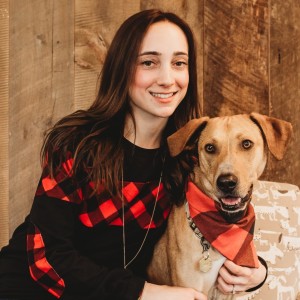
Danielle Vrabel, CPDT-KA
Danielle Vrabel is a dog trainer who earned her CPDT-KA in 2020. Danielle is a proud pet mom of five pets: two dogs, two cats, and a corn snake. Danielle has fostered over 10 dogs and 15 cats/kittens as well as helped train shelter dogs before they are adopted. Both of Danielle’s dogs are pet therapy dogs, where she also volunteers her time helping evaluate future therapy dogs.
Related articles
![Australian shephard and Corgi mix play fighting outside]() opens in a new tab
opens in a new tabHow to Recognize the Signs of Dog Aggression
A PSA to pay better attention to our best friends’ body language.
![One dog sniffing another dog, outside on a leash.]() opens in a new tab
opens in a new tabHow to Introduce Dogs When One is Aggressive
Some good ways to keep everybody safe.
![A persons arm around a dog in a park.]() opens in a new tab
opens in a new tabHow to Learn the Signs of Aggression In Dogs So You Can Get Them Some Doggy Therapy
Experts agree: breed doesn’t have anything to do with it.
![Two Australian Shepherd dogs meeting in the snow]() opens in a new tab
opens in a new tabAre Your Dogs Arguing With Each Other?
How to tell the difference between dog aggression and communication.
![A man with long brown hair playing tug -of-war with his Golden Retriever dog outside on a wet tennis court]() opens in a new tab
opens in a new tabPlay-Training Can Be Your Solution to Dog Aggression
Behavior correction, Mary Poppins style: Turn a job into a game.
![Man kneeling and kissing the head of his white and tan dog on a wooden pier]() opens in a new tab
opens in a new tabBest Training Rewards for Your Dog
Positive reinforcement is in the eye of the beholder
